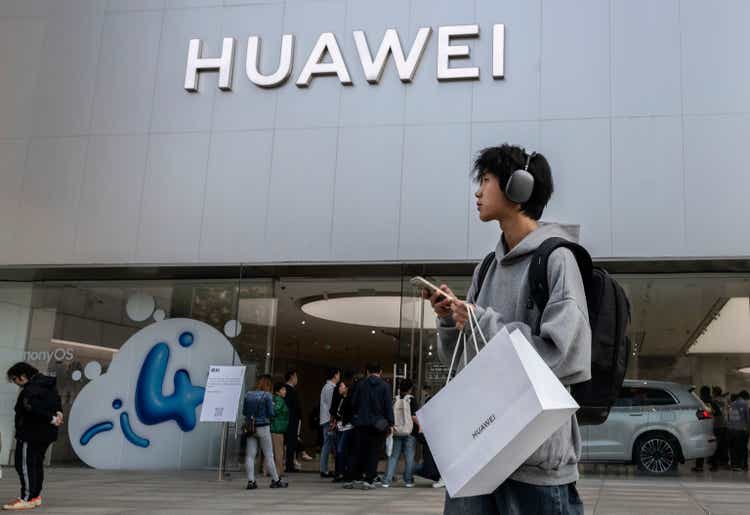
Kevin Frayer/Getty Images News
Huawei Technologies’ plan to develop more powerful chips for AI and phones is facing hurdles due to the U.S. export curbs, Bloomberg News reported.
The Chinese tech giant is designing its next two Ascend processors, a potential rival to Nvidia’s (NVDA) chips, around the same 7-nanometer architecture which been mainstream for years, the report added citing people with knowledge of the matter. The reason being that Huawei’s chip making partners have not been able to get ASML’s (ASML) extreme ultraviolet lithography, or EUV, systems due to U.S. export restrictions.
This would mean that Huawei’s main chips will be stuck at an older technology till at least 2026, the report added.
Huawei’s smartphone processors for its Mate lineup of phones has seen similar constraints.
In September it was reported that Huawei and its chip making partner Semiconductor Manufacturing International (OTCQX:SIUIF) were struggling with production of the chips used in Huawei’s next flagship phone Mate 70 due to the continuing impact of the four-year-old U.S. ban on the supply of chip manufacturing tools to the companies.
Earlier this week, Huawei began taking pre-orders for the Mate 70 smartphone models and is expected to unveil the devices on Nov. 26.
Development snags faced by Huawei also have broader implications for China’s AI ambitions. The Asian country would further lag behind the U.S. in 2025, when Taiwan Semiconductor Manufacturing (TSM) — chipmaker to Apple (NASDAQ:AAPL) and Nvidia — starts making 2nm chips, which are about three generations ahead, the report noted.
Meanwhile, Huawei’s production partner SIUIF is struggling to make even 7nm chips at steady volumes as its 7nm production lines have been impacted by poor yield and reliability issues, according to the report.
In August, it was reported that Chinese internet companies and telecommunications operators have been testing Huawei’s new chip known as Ascend 910C. Huawei, reportedly, told potential clients that the new chip was comparable to Nvidia’s H100, which was unveiled last year and is not directly available in China. However, Huawei has been facing manufacturing delays for the current chips.
In recent years, Huawei has assumed a key role in China’s ambitions to be self-reliant in critical areas including semiconductors and AI.
However, one of the main impediments is the inferior quality of Chinese equipment, and the unavailability of EUVs has made advanced chip making difficult.
To boost local manufacturing, in September, the Ministry of Industry and Information Technology advised state-linked organizations to use domestically developed deep ultraviolet, or DUV, lithography machines. China touted two homemade advanced chip-making machines.
Meanwhile, state-backed chip manufacturers have been trying to push the limit of ASML’s older DUV machines, the company’s second-best product after EUVs, with the so-called quadruple patterning technique, the report added.
However, this effort is not going well because of inferior domestic gear used along with ASML’s DUV machines. On at least one trial production line, engineers had to replace Chinese equipment with foreign gear to make sure there was reasonable output, the report noted.
Huawei requires tens of millions of Kirin-branded chips annually for its own smartphones, and intends to develop hundreds of thousands of Ascend AI chips, the report added. This year, China urged local companies to avoid using Nvidia’s chips and instead use local alternatives such as those from Huawei, according to the report.
Huawei was once in competition with Apple (AAPL) and Samsung (OTCPK:SSNLF) to be the world’s biggest handset maker until U.S. restrictions, starting in 2019, began to curb its access to chip manufacturing tools needed to produce its most advanced models.
However, last year in August, Huawei surprised many by quietly launching its new flagship smartphone, Mate 60 Pro, reportedly a 5G capable phone.
The chip inside the phone ignited concerns in the U.S. and raised questions about how it was possible, without the company being able to access critical technologies. In April, Huawei unveiled its Pura 70 series, which features the Kirin 9010 chip, a follow-up to the Kirin 9000s reportedly made by Semiconductor Manufacturing International (OTCQX:SIUIF) for the Mate 60 Pro.
